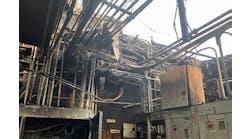Digital thread enables enterprise continuity
“A digital thread can extract insights and deliver real value.” Rockwell Automation’s Sujeet Chand explained how open standards, virtualization and the cloud can provide continuity throughout a product’s lifecycle.
As an element central to the larger digital transformation trend, digital threads are more widely recognized than they are fully understood.
Sujeet Chand, senior vice president and chief technology officer, Rockwell Automation, intends to fix that.
Chand shared this mission during his November 16 Automation Fair At Home presentation, “Digital Thread: From Siloed Data to Enterprise Continuity,” which focused on enabling end users to accelerate their performance and achieve greater sustainability while realizing a truly connected enterprise courtesy of a strategically implemented digital thread.
“We often hear about digital threads and digital twins but we don’t often hear about how to use them,” Chand explained while introducing a series of videos that showcased a functioning factory implementing the approaches he described.
A challenge when looking at different functions across an enterprise, the presenter said, is the variance in machine design and plant operations. Functions are siloed. There are legacy assets relying on legacy software applications in which data is locked up. “But if you connect these together, if you use open standards and virtualization and the cloud, the value can be enormous,” beamed Chand. Setting up those connections must be strategic.
The old process goes like this: the end user tells the machine builder what type of machine they want. The OEM shows them the prototype, they request updates, and the process begins again. And again. And again.
“But with browser-based computer design, the end users and engineers and OEMs can simultaneously design the machine from different locations,” he explained. “There is real-time collaboration around one element of truth. This is helping groups collaborate.”
The next video focused on the design of the manufacturing line for Rockwell Automation C-100 contactors, a product complete with 650 available variations that can be manufactured at the company’s Milwaukee facility with zero set-up time between variations. The digital thread is linked to the design and emulation processes, incorporating insights gleaned from simulated stresses on the manufacturing equipment itself, such as a robot arm. “We can predict when, say, a certain joint will be over stressed. We can do this in real time.”
Working smarter with the right data
Chand noted how the digital thread is maximizing workforce productivity, using the example of a new operator receiving guidance to repair a downed production line courtesy of consultation from an off-site expert using virtual reality via a handheld device. “Once you have that augmented reality in your system, this becomes a powerful tool for training. It speeds workforce development.”
He explained the use of smart objects that feed analytics into digital twins to enable greater flexibility and inform larger business outcomes; this approach limits the old problem of overwhelming data scientists with mountains of needless information. The smart approach is to model the data at the source, said Chand, right where it is generated. Properly tagging the data organizes it, which enables that data to be more quickly translated into business value courtesy of a digital thread. “A digital thread can extract insights and deliver real value,” said the VP.
The session closed with Q&A, enabling the audience to pick Chand’s brain.
What role is disruption caused by the COVID pandemic having on digital-thread adoption?
“It has gotten many companies talking about resilience, automation productivity and sustainability. The digital thread helps build a more resilient supply chain, particularly, for example, in the pharmaceutical industry where many ingredients come from Asia.”
Can these applications of the digital thread be used in environments that rely on relationships with many companies?
“In the ideal world, everyone is a one-stop shop. But in reality we have legacy assets and different applications. The people working with them don’t want to change that. You’re always going to have multi-vendor environments any time you’re implementing digital thread. And it makes sense to partner with others. No one company can execute digital transformation by themselves. All these different pieces are involved, from supply chain to emulation to the automation software. And the digital thread integrates relevant data from all different applications.”
Is Rockwell Automation using the digital thread in its own operations?
“We have implemented multiple digital threads. Consider the engineering products we build based on customers’ specs. A customers can place an order into our ERP system, which automatically generates a work order and work instructions for the manufacturing plant, then schedules the job and even tracks how the product is being built. That all integrates within a digital thread.”
How are customers adopting these approaches?
“The pandemic has accelerated digital transformation for many companies. They have to think differently. No company can do this alone. The digital twin and the digital thread require multiple companies and open architectures to produce solutions. We at Rockwell Automation position ourselves with partners to use the digital thread to provide new business value for our customers.”
[sidebar id=3]
The editors of Control, Control Design and Smart Industry are providing coverage of Automation Fair At Home, bringing you breaking news, innovations and insights from the virtual event. Once Automation Fair At Home is over, the editors will put together an event report featuring the top news. Pre-order your copy today.





